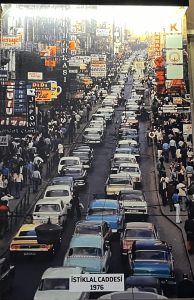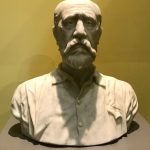“Independence Road”
If there’s one place outside of Sultanahmet that everyone should visit it has to be İstiklal Caddesi, the insanely busy pedestrianised street that runs all the way from Taksim Square to the funicular at Tünel. Everything happens here. Street musicians from all over the world go through their paces (or they used to until a bomb in 2023 led to their being banned from the street for the time being). Restaurants and cafes dish up the widest choice of meals to suit the widest range of budgets. Art galleries offer the latest in cultural distraction. And in between them all the crowds surge ever onward, window-shopping, people-watching and just plain passing the time of day.
In the 19th century İstiklal Caddesi was the heart of Beyoğlu, the part of town where the embassies were gathered. Banks and insurance companies were also based here while a handful of grand hotels such as the Tokatliyan catered to visitors. Fashionable shops and cafes lined the street. With the exception of St Anthony’s, churches kept a low profile in the side streets. The prestigious Galatasaray Lisesi (High School) straddled its mid-point. To get a taste of what life here might once have been like you should peer through the window of the once-elegant Markiz Pastanesi, a cakeshop at the Tünel end of the street now sadly shuttered.
But in the 2010s the character of the street changed considerably as the one-off shops gave way to the same-old same-old chain stores (my particular heartsink moment came when the original branch of the Konak kebab shop changed into a branch of Mavi Jeans). The coming of the massive Demirören shopping mall in 2011 was not greeted with universal delight despite an architectural nod towards Neoclassicism. The conversion of the elegant Emek Han right next door found a little more favour.
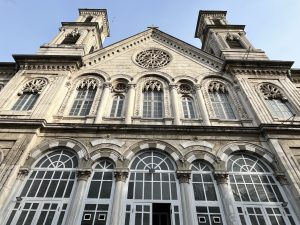 Tip: If you want to explore İstiklal Caddesi’s small art galleries, avoid Mondays when many of them will be closed.
Tip: If you want to explore İstiklal Caddesi’s small art galleries, avoid Mondays when many of them will be closed.
From Taksim to Tünel – east side of street

Start down Istiklal, then turn left just before the Türkiye İş Bankası building. The side street leads to the Greek Orthodox Hagia Triada (Holy Trinity) church, built in 1880 to the designs of Vasiliki Ioannidi. With two tall towers and a huge dome it dominates the skyline as you look south from Taksim Square. Until the end of the 19th century the Ottoman sultans had forbidden domes on any building other than mosques, so Hagia Triada was created as a triumphant celebration of new freedoms. If the caretaker is around you might be able to go inside to see the soaring iconostasis, the stupendous painted dome and the enormous chandeliers. Otherwise you’ll have to make do with the narthex.
Keep walking until you get to Büyükparmakkapı Sokak, then turn left. On your left you’ll see the old Afrika Han, one of three early business centres in the area that were owned by the wealthy bureaucrat Ragıp Paşa (1857-1920). The most obvious of the three is the elaborately decorated Cite de Roumelie on the opposite side of İstiklal Caddesi.
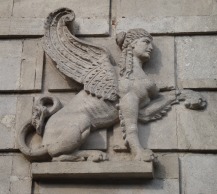 Just before you reach the Galatasaray Lisesi a turning on the left, Kartal Sokak, doglegs towards the Galatasaray Hamam. Originally founded in 1498 as part of a school for Balkan boys, the hamam was completely rebuilt in 1715 and became part of the high school. A more mundane women’s section was added in 1965. On its way to the hamam the street passes on the left the Zografyon Greek Boys School designed by P D Fotiadis in 1893 with griffons on its facade.
Just before you reach the Galatasaray Lisesi a turning on the left, Kartal Sokak, doglegs towards the Galatasaray Hamam. Originally founded in 1498 as part of a school for Balkan boys, the hamam was completely rebuilt in 1715 and became part of the high school. A more mundane women’s section was added in 1965. On its way to the hamam the street passes on the left the Zografyon Greek Boys School designed by P D Fotiadis in 1893 with griffons on its facade.
Midway along İstiklal Caddesi you will see the high walls and equally high gates concealing the Galatasaray Lisesi (High School). This opened in 1868 and was alma mater to many famous Turks including the pop star Barış Manço. To see into its impressive gardens take the lift up to the café on the fifth floor of the Beyoğlü Han buiding immediately across the road. Beyond the school you will also be able to see Sarayburnu, the Topkapı Palace, Ayasofya and the Blue Mosque.
On the far side of Yeniçarşı Caddesi, which runs down to Tophane from beside the school, the small Galatasaray Meydanı (Square) is adorned with a not particularly beautiful monument to the 50th anniversary of the founding of the Turkish Republic in 1973. These days it’s hard to see it for the police and barriers that surround it.
 Misr ApartımanıImmediately beside the square is a large bookshop and the Yapı Kredi Kültür Merkezi which hosts an impressive programme of art and archaeology exhibitions, all of them open free. Gazing out from its windows is İlhan Koman’s striking statue, Akdeniz (Mediterranean).
Misr ApartımanıImmediately beside the square is a large bookshop and the Yapı Kredi Kültür Merkezi which hosts an impressive programme of art and archaeology exhibitions, all of them open free. Gazing out from its windows is İlhan Koman’s striking statue, Akdeniz (Mediterranean).
Keep heading along İstiklal Caddesi and you will pass the vast Mısır Apartımanı, an apartment block that houses on its top floor the trendy 360 restaurant. It was designed by the Armenian Hovsep Aznavuryan (1854-1935) and served as a winter home for the Egyptian Khedive Abbas Halim Paşa, hence its name, the Egyptian Apartments. Most of the lower floors house small art galleries, all of them welcoming visitors.
Close by is the huge St Anthony’s Cathedral (St Antoine’s), by far the most conspicuous of the many churches in this area. With its grand brick gateway and annexe builidngs and its High Gothic interior, it’s a little piece of France mixed with Italy and still offers regular services today. In front of it stands a statue of Pope John XXIII (Angelo Guiseppe Roncalli, 1881-1963), a Turkish speaker who, from 1935 to 1944, served as the Pope’s ambassador to Turkey and as a priest at the church. Because of the work he did in helping Jews escape the Nazis “the Turkish Pope” was dubbed a “Righteous Gentile”. Recently a very beautiful sculpture of a distorted Crucifixion was also placed in front of the church.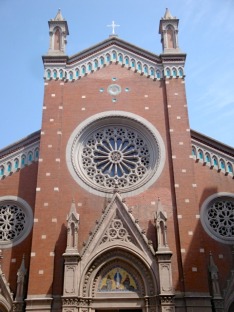 St Anthony’s
St Anthony’s
A little further on the Koç University Research Centre for Anatolian Civilisations (Anamed, tel: 0212-393 6000) hosts a range of exhibitions, mostly not all always to do with İstanbul.
The street starts to climb more steeply at this point and passes the Dutch Consulate built in 1855 by the Swiss brothers Guiseppe and Gaspare Fossatti. Admire its fine exterior through the gates, then turn down Tomtom Kaptan Sokak beside it which passes the consulate chapel before arriving in “Little Itally” with the Palazzo de Venezia (1695), once the embassy of the Venetian Republic to the right. After a somewhat chequered history which included a visit by Casanova in 1744 it now serves as the Italian Consulate.
 Santa Maria DraperisOn the opposite side of the road is the pretty French Court, built in the 18th century and, like the British Prison in Galata, evidence of the way in which the Ottomans allowed the different “millets (nationalities)” to conduct their own justice systems.
Santa Maria DraperisOn the opposite side of the road is the pretty French Court, built in the 18th century and, like the British Prison in Galata, evidence of the way in which the Ottomans allowed the different “millets (nationalities)” to conduct their own justice systems.
A little further along İstiklal Caddesi is a cafe with a wonderful Art Nouveau interior, complete with its original wooden cabinets and galleries. Then you will come to Mesher (closed Mondays), a small art gallery that hosts excellent changing art shows.
Continuing along the road an archway with a statue of St Mary above it marks the Santa Maria Han with steep steps running down inside it to the Church of Santa Maria Draperis, a beautiful, barrel-vaulted structure designed by Gugliemo Semprini in 1904 and named after the Genoese woman, Clara Bratola Draperis, on whose land it was built.
Past the han is the Beyoğlu Belediyesi Sanat Galerisi (closed Mondays) and then the Russian Consulate, designed, like its Dutch counterpart down the street, by the Fossatti brothers in 1837.
 Stone roses of Casa BotterBetween 1900 and 1901, Raimondo d’Aronco built the fabulous Casa Botter (closed Mondays) for the sultan’s tailor, Jean Botter. İstanbul’s first Art Nouveau structure, it is festooned with gorgeous stone roses, giant sphinx-like heads and wonderful wrought ironwork that includes dramatic protruding flowers. Inside, even the windows contain stained-glass roses. In 2023, it opened to the public as a cultural centre with changing exhibitions. One of its last residents was the writer Ferit Edgü (1936-2024) who sometimes included the building in his stories.
Stone roses of Casa BotterBetween 1900 and 1901, Raimondo d’Aronco built the fabulous Casa Botter (closed Mondays) for the sultan’s tailor, Jean Botter. İstanbul’s first Art Nouveau structure, it is festooned with gorgeous stone roses, giant sphinx-like heads and wonderful wrought ironwork that includes dramatic protruding flowers. Inside, even the windows contain stained-glass roses. In 2023, it opened to the public as a cultural centre with changing exhibitions. One of its last residents was the writer Ferit Edgü (1936-2024) who sometimes included the building in his stories.
Right beside the Casa Botter is the Swedish Consulate designed in 1869 by Domenico Pulger. Its garden is a haven for the many street cats who prowl this area although since a Koran-burning incident in Stockholm in 2023 it was been fortified against intruders.
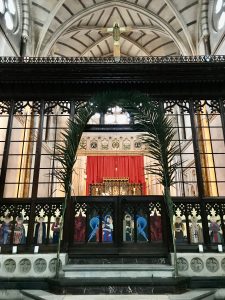
Turn left beside the Şişhane Metro station and head downhill, passing on the right the German School in its large garden. You will arrive in Serdar-ı Ekrem Sokak, the heart of trendy Galata. Turn left and then right and on the right you will see a curious piece of Victorian Gothic in the shape of Christ Church, the Crimean Memorial church, designed by G E Street and completed in 1868. Closed in the 1970s, it was painstakingly restored under the guidance of the current priest and reopened in 1991. Its magnificent rood screen was designed by the Scottish artist Mungo McCosh and depicts well-known members of the expat community in the guise of saints against a backdrop of the İstanbul skyline. Recitals on a Hill and Sons organ dating back to 1911 are held here every Saturday and Sunday.
From Tünel to Taksim – west side of street
If you come out of Tünel station you will be facing the elegant 19th-century Tünel Geçidi. Bear right and you will come to the start of İstiklal Caddesi with the TC Ziraat Bankası on your left and Şişhane Metro station on the right.
Just beyond the bank, facing the Swiss Consulate, is the distinctive Narmanlı Han with its heavy attached Doric columns. Once home to the Russian Consulate, in the period leading up to the Second World War it became a place where the 20th-century equivalent of the chattering classes met to exchange ideas over çay. Perhaps the most famous regular was the novelist and MP Ahmet Hamdi Tanpınar (1901-62). Later, the artist Aliye Berger lived in the apartment with a balcony overlooking the street corner. Unfortunately a courtyard once filled with cats and partridges is now full of cafes, the building’s history largely forgotten.
Not far from the Narmanlı Han stands a long-suffering Art Nouveau gem, the Markiz Pastanesi, once another favoured meeting place for the chattering classes. It belonged to a man named Lebon who was brother-in-law to the Levantine architect Alexandre Vallaury, the man responsible for the nearby Pera Palace Hotel. Today what was once a stylish café with a whiff of Vienna about it stands locked and empty. Peer through the window to admire two wonderful ceramic panels depicting spring and autumn that look as if they must be works of Mucha but were actually by the French ceramicist, J.A. Arnoux, and were imported from Paris.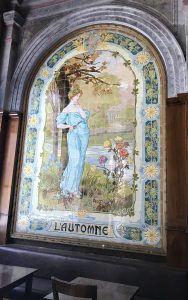
As you pass it’s worth ducking into the secretive Suriye Pasaj shopping arcade which houses in its basement By Retro, one of İstanbul’s finest vintage clothes shops.
Nearby SALT (open daily, tel: 0212-377 42 00, https://saltonline.org/) is an impressive multi-media gallery housed in one of İstiklal Caddesi’s 19th-century mansions, its ground-floor supported by iron columns. Regularly changing contemporary art/avant-garde exhibitions run on the upper floors while the ground floor features a drop-in cinema – grab a programme in advance to make sure you catch the start of the best showings. The small café is another plus as is the branch of the English-language bookshop, Robinson Crusoe.
A jarring intrusion into the generally elegant buildings of İstiklal is the Odakule, a towering 1970s structure which most people only know because it provides a short cut through to Meşrutiyet Caddesi and the Pera Museum.
The narrow Danışman Geçidi is decorated with pictures of the Galata Tower and Kızkulesi in roundels above the entrance. Walk through to discover the cobbled Huzzopulo courtyard which used to have several small tea shops, all except one of them closed in 2023. It serves as another short cut for getting to Meşrutiyet Caddesi and Tepebaşı and is home to Katia’s, a bespoke hat shop that is the last survivor of the old Greek shops of İstiklal Caddesi.
Nearby the Aznavur Pasajı (Arcade) was erected in 1924 and houses many small shops. Stand back from it and you’ll be able to see that it was created in Art Nouveau style out of iron.
Shortly after passing the arcade you cross the road leading left to the British Consulate. On the far side of the road is what was, when it opened in 1875, the appropriately grand local Post Office building (compare and contrast with the mundane model across the square in Yeniçarşı Caddesi). Today it houses a philately museum as well as temporary exhibition space.
Soon after you pass the Galatasaray Museum you’ll spot the Balık Pazarı (Fish Market) which is, not surprisingly, full of stalls selling fresh fish alongside lots of fruit, veg, delicatessen-style produce and fried mussels alongside a growing flood of tourist tat. On the right wooden doors lead through to a courtyard in front of the Üç Horon (Holy Trinity) Armenian church, built in 1838 on the site of a 16th-century church. The barrel-vaulted church is usually open to visitors.
Keep walking through the Fish Market and turn right into Nevizade Sokak which is lined with meyhanes, the Greek-style tavernas that evolved in this area when there was still a large Greek population.. During the day you can walk through it and find it silent only for darkness to fall whereupon it turns into a seething sea of raucous diners.
Alternatively turn left into the Avrupa Pasajı, an undercover shopping arcade decorated with Classical statuery and full of antique and souvenir shops – and more tourist tat.

Right beside the Fish Market is the famous Çiçek Pasajı (Flower Arcade), built in 1870 as the Cite de Pera by Zografos Efendi to house small shops. Later it was home to the Naum Theatre which burned down in 1870. These days it’s full of meyhanes, this time undercover. It takes its name from the White Russian flower-sellers who sought refuge in Constantinople after the Bolshevik Revolution.
The immensely popular Tokatliyan Hotel (AKA the Hotel Splendide), opened in 1897 beside the arcade and hosted the likes of Trotsky and Atatürk before falling on hard times in the 1950s. It was from a barber’s shop in the hotel that ex-UK PM Boris Johnson’s great-grandfather, Ali Kemal (1869-1922), was snatched and later lynched. Today only its second branch in Tarabya is still in business, albeit in different ownership.
Turn left down Balo Sokak and walk to the end where, on the right, you will find the small Doğançay Museum housed in a restored 19th-century mansion. Burhan Doğançay (1929 – 2013) was one of Turkey’s best-known contemporary artists with several works on display in the İstanbul Modern Art Gallery as well as here and in foreign collections. The top floor of the museum displays paintings by his father Adıl (1900-90).
It’s worth taking a look around the Halep Pasajı (Arcade, AKA Cite d’Alep/Aleppo Arcade) which was commissioned by a Syrian in 1885 and once housed a circus. Today it’s home to a more prosaic cinema and a few shops with a rather alternative feel to them.

Usually conspicuous for the blue-and-white Greek flag fluttering in front of it, the Şişmanoğlu Megaro houses the Greek Consulate but is often used for temporary exhibitions usually to do with aspects of Ottoman Greek life.
The grand and beautiful Emek Pasajı (Arcade) was built for the Armenian plutocrat, Abraham Paşa, in 1884 and was once home to the elitist meeting place, the Cercle d’Orient, occasionally open to the public during city festivals. Most of the building now houses shops and cafes although the Turkish branch of Madam Tussauds (open daily, admission TL780) can also be found here too.
Across a side road from the huge, modern Demirören Shopping Mall, the Ağa Camii was the only mosque on İstiklal Caddesi before the Taksim Cami came along. The existing building mainly dates from 1834 although parts dates back to 1594 when Hüseyin Ağa, the Commander of Galatasaray, had it built as an extension of the Galata Palace.
 Entrance to Cite de Rumelie with name in three languages
Entrance to Cite de Rumelie with name in three languages
Just past the mosque is one of the most beautiful of the İstiklal arcades, the Cite de Roumelie/Agora Romelias whose name appears on the facade in Greek, Ottoman Turkish and French. It was paid for by Ragıp Paşa who also commissioned the nearby Afrika and Anadolu Hans.
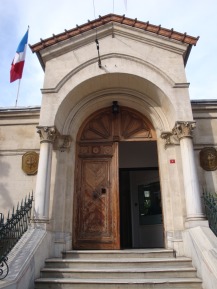 French ConsulateA little further along the road is the Akbank Art Gallery which hosts an interesting variety of temporary exhibitions and concerts. As you near Taksim Square you’ll pass the elegant low-slung stone building (1898) that houses the French Consulate. It was erected on the site of an 18th-century plague hospital and houses a cafe, French bookshop and exhibition space. Immediately behind it is the Armenian Church of Surp Pırgiç.
French ConsulateA little further along the road is the Akbank Art Gallery which hosts an interesting variety of temporary exhibitions and concerts. As you near Taksim Square you’ll pass the elegant low-slung stone building (1898) that houses the French Consulate. It was erected on the site of an 18th-century plague hospital and houses a cafe, French bookshop and exhibition space. Immediately behind it is the Armenian Church of Surp Pırgiç.
As Taksim square comes into view you’ll see an 18th-century octagonal stone building with a marble fountain in its side. This was the maksem which used to serve as a water distribution system (the water was stored in the large cistern that runs along one side of Taksim Square). The Koranic inscription over the door reads ‘Everything was created from water’. Two tiny birdhouses were added to the facade in the 19th century.
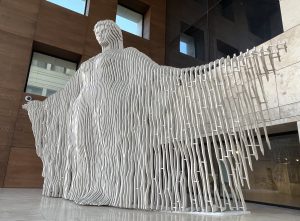
Eating
Want to grab a quick, cheap bite? Then the Taksim end of İstiklal Caddesi is known for its many döner kebabı stands as well as for its more unlikely ıslak (wet) burgers, a sort of Turkish take on a spicy McDonald’s.
Fıccın Rare chance to sample Circassian cuisine including tulen, the Caucasian take on chicken soup, and a variety of mantıs (mini dumplings). Kallavi Sokak No. 3, Tel: 0212-245 4858
Mandabatmaz There are branches of Starbucks aplenty along İstiklal Caddesi but if you want the taste of a good old-fashioned Turkish coffee then duck down this unpromising alley to find the real thing in a pocket handkerchief-sized cafe with barely room to sit down. The name means something like “the buffalo doesn’t sink”. Olivia Geçidi No. 1/A
Lades (Wishbone) 2 One of the best places in Istanbul to try out a popular breakfast staple called menemen, which is a cross between scrambled eggs and omelette, and very tasty too. Oh, and there’s plenty of chicken on offer as well. Sadri Alisik Sokak No. 14, Tel: 0212-251 3203
Zübeyir Ocakbaşı & Restaurant One can only imagine the stir it must have caused when actor Ralph Fiennes of The English Patient fame dropped by in 2011 to sample the offerings at this small grill housed in the basement and ground floor of the Art Nouveau Ferah Apartment block designed by A and J Caracach. It’s a meat-eaters’ paradise although the service can be a little inconsistent. Bekar Sokak No. 28, Tel: 0212-293 3951
Sleeping
Richmond Hotel
The only hotel right on İstiklal Caddesi is not great for the mobility-impaired since it has stairs up to its lobby but is otherwise very convenient. İstiklal Caddesi No. 227, Tel: 0212-252 5460
 Transport info
Transport info
The Taksim Square (north) end of İstiklal Caddesi is accessible via the funicular up from Kabataş, itself accessible by tram from Sultanahmet.
The Tünel (south) end of İstiklal Caddesi is accessible via funicular from Karaköy, itself accessible by tram from Sultanahmet. Alternatively you can get to it by Metro to Şişhane.
A nostalgic tram trundles along İstiklal Caddesi stopping in front of the Ağa Cami, the Galatasaray Lisesi, Odakule and the Şişhane Metro station. It’s a slow and infrequent but fun way to get along the street although if you hop on and off the fares will quickly mount up.
Nearby areas
